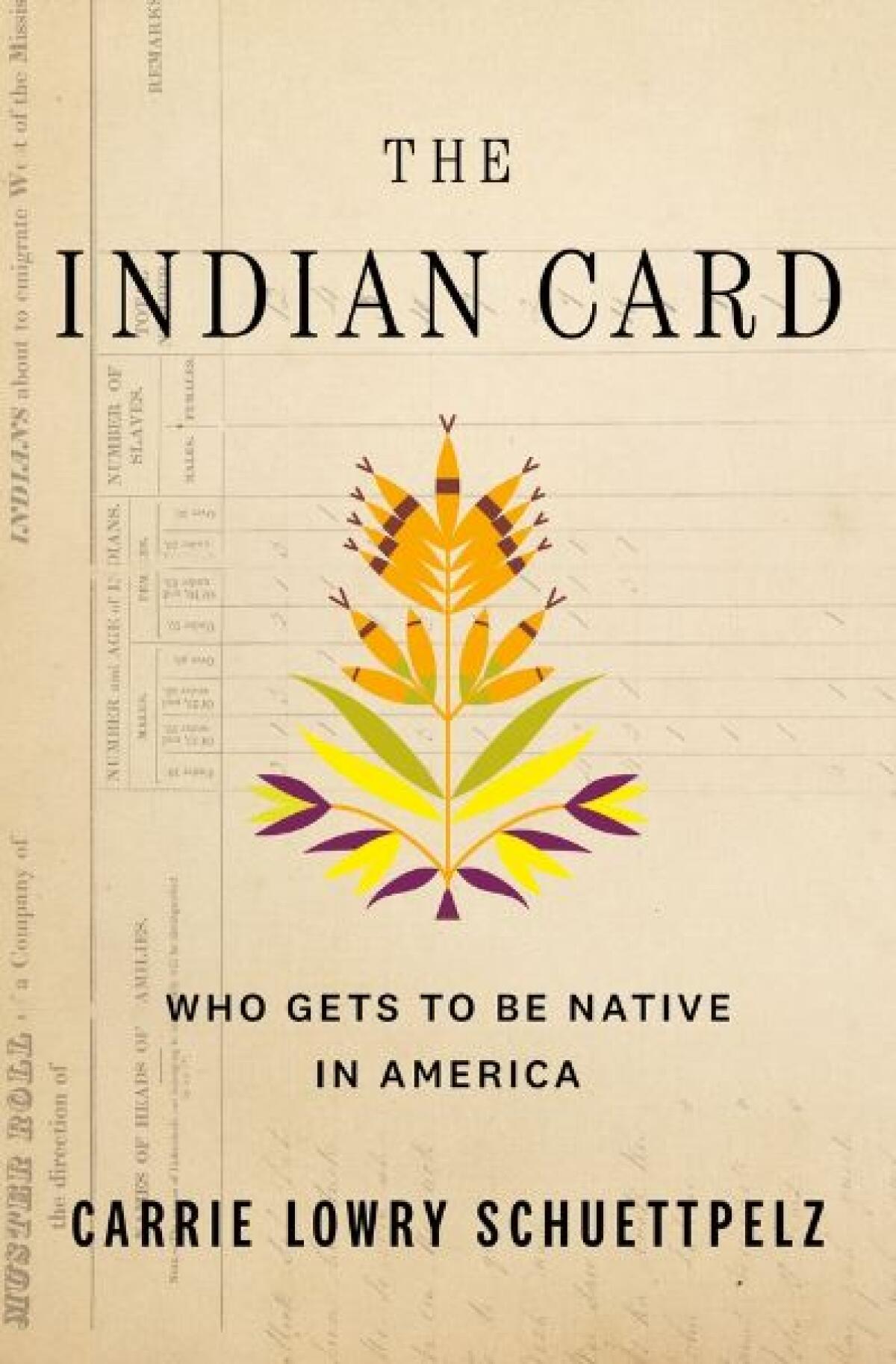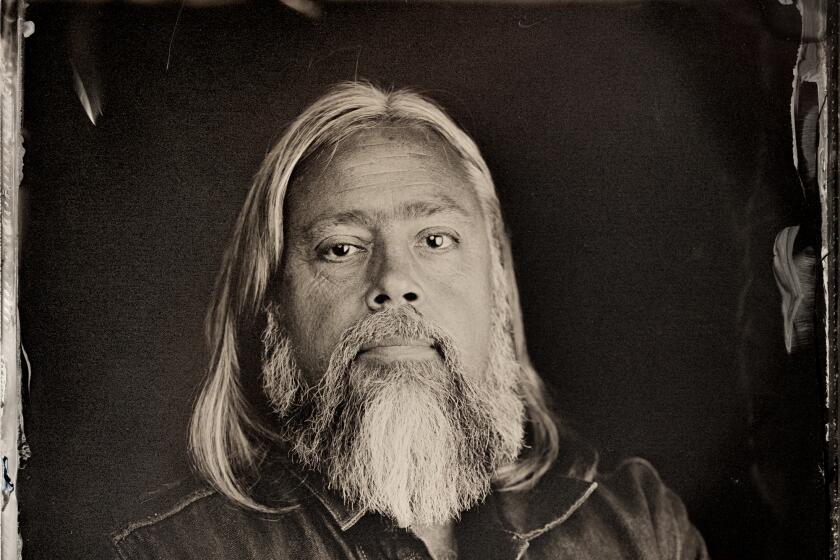The open question of ‘who gets to be Native in America’

Book Review
The Indian Card: Who Gets to Be Native in America
By Carrie Lowry Schuettpelz
Flatiron: 304 pages, $29.99
If you buy books linked on our site, The Times may earn a commission from Bookshop.org, whose fees support independent bookstores.
“The Indian Card” begins with a statistical puzzle: In the 2000 U.S. census, 4.1 million people indicated Native American heritage. But in 2020, that figure had swelled to 9.7 million. And yet there had been no baby boom.
Here’s another wrinkle: There were only about 1.9 million enrolled members of tribes in the contiguous U.S. in 2020.

In these gaping discrepancies, author Carrie Lowry Schuettpelz saw a need for stories to be told. An enrolled member of the Lumbee Tribe of North Carolina who served in the Obama administration, Schuettpelz is an expert on Native policy and homelessness. Data has been her stock in trade. So how does she find meaning in these anomalies? By finding context.
“The Indian Card” amplifies the accounts of many who have been affected by a flawed one-size-fits-all notion of identity. Following along, one can begin to imagine how the number of Americans claiming Native identities might fluctuate by millions, even in a decade.
‘Becoming Little Shell’ is the story of one man discovering his heritage, but along the way he sees how so many others have been dispossessed in so many ways.
Schuettpelz gathers the testimonies of individuals about bonds that tie them to their tribe and how membership grounds them. She also recounts experiences that led to greater alienation and isolation, as some people were denied membership in tribes with which they identified or as whole tribes were denied federal recognition.
To be meaningful, a conversation about Native American heritage must take place at this level of granularity, Schuettpelz writes, because there are 347 recognized tribes in the contiguous United States: “Treating ‘Native America’ as a monolith is a bit like claiming interest in ‘Asian culture.’ There isn’t just one.”
The federal government has its own complicated processes for recognizing tribes. Regardless of that status, each tribe and nation can determine whom to include. Decisions could hinge on patrilineal or matrilineal descent, a direct relative’s name on a 19th century federal list of tribal members or other documents that tie an individual to a tribe. Some tribes determine the fraction of one’s bloodline that justifies membership. Historically, others have defined their people through shared oral traditions or shared languages, or consanguinity or habitation.
Bill Vaughn’s ‘The Plot Against Native America’ is on the right side of history, but an editor and a sharper focus would have helped.
Questions of identity are personal for Schuettpelz. She grew up in Iowa, more than a thousand miles from the territory of the Lumbee Tribe of North Carolina. Her parents enrolled her as a tribal member when she was a little girl. Her family’s trips back to North Carolina brought her into a community of kinship, a permanence tied to a homeland, personal stories that gave her a sense of belonging that contrasted with her family’s isolation in Iowa.
As the book opens, she is trying to make a decision about her own two young children. What would it mean in their lives to be recognized for their kinship in that tribe? In what ways does it matter that the Lumbee Tribe of North Carolina is not yet recognized by the U.S. government?
At the heart of tribal recognition is the notion of sovereignty, a word this book describes as a love language full of cultural and historical meaning. In simplest terms, it’s the ability of a tribe to govern itself, to have jurisdiction over its lands, a right to determine its own future. In this country’s bloody history, tribal sovereignty is a testament to survival and a source of pride.
For the federal government, however, defining tribes and counting Native Americans became crucial only because of brutal policies under President Andrew Jackson in the 1830s, evicting individuals who had been enumerated on “muster rolls.” But the rolls themselves were shoddy, often based on cursory observations of supposed racial markers such as the color of skin, facial structure and hair texture, or on lists of members that tribal leaders provided under treaty terms.
After World War II, the government began a new policy that simply terminated recognition of hundreds of tribes, stripping any claimed tribal sovereignty over their lands. Despite a later effort at correcting this, in California alone, 12 tribes were terminated and still have not had their tribal rights restored. A tribe’s struggle for recognition can be arduous.
Individuals’ relationships with their own Native identity are complicated in their own ways. Consider the almost 8 million Americans who identified as Native on the 2020 census but are not members of recognized tribes. Why would they check the “Native” box? Some are members of unrecognized tribes. Some may be embracing unverified family lore, perhaps of a distant Cherokee ancestor. Others might claim a minority identity in the hope of preferential treatment in hiring or college admissions, or for cultural cachet. Whether most of these people descend from pre-Columbian Americans is anyone’s guess.
Some “pretendians,” historically, are motivated by greed. One pernicious old myth is that being Native American brings abundant federal subsidies or income from mineral rights or casinos — think “Killers of the Flower Moon” and Osage oil money. Tribal offices receive calls from strangers claiming Native American DNA and demanding some of that mythical money, Schuettpelz relays.
The reality, however, is that Native Americans endure rates of poverty and homelessness many times higher than those of white-identified Americans. “The Indian Card” finds real benefits that can derive from tribal membership, but instant wealth is not among them. And the pursuit of belonging can be painful.
Calculations of “blood quantum” are still common among many tribes, but the formula has been rigged against Native Americans from the start. Unlike racist crackpot notions such as the supposed “one drop” rule that determined who could be enslaved or who would be subject to Jim Crow apartheid, when it came to determining who qualified as Native American, the white supremacist government held itself arbiter of who wasn’t Native based on certain percentages of white ancestry. The government wanted to diminish the numbers of Native Americans and replace tribal identity with whiteness.
For more than 500 years, Native Americans and individuals from Europe and Africa have been blurring and redrawing the lines between their peoples, and across those centuries, millions of individuals have had millions of reasons for identifying with one or more sides of their ancestry. Before the 2000 census, that complexity was officially invisible, because each resident could declare only one race.
For 200 years, the federal government has wielded official recognition as a weapon and a wedge; in all that time, many tribes themselves have tried to abide by long-discredited old Eurocentric notions of race, with tragic results.
So of course Schuettpelz can’t offer a simple explanation for the book’s opening puzzle about what changed between 2000 and 2020. When it comes to Native American identity, change has been the only constant. Only the 7.8 million individuals themselves could explain why they identified as Native in 2020 but were not officially members of a recognized tribe.
The big questions that drove Carrie Lowry Schuettpelz to examine the data, to seek out individual stories and collective histories, can be only partially answered. The most satisfying explanation may lie in the microcosm she generously shares with readers: Unpacking the ways that she knows herself as Lumbee, she establishes the ways her kids will know and be known by her community.
Lorraine Berry is a writer and critic living in Oregon.
More to Read
A cure for the common opinion
Get thought-provoking perspectives with our weekly newsletter.
You may occasionally receive promotional content from the Los Angeles Times.












